Chapter 17 Cattle Breeding and Management
The CSIRO is now doing a lot of research into biological control, and I think this is a great step forward, as too much spraying, drenching, hormone injections etcetera, can affect our meat. They have had many great achievements in this field: the control of prickly pear, control of rabbits and now their work on blow flies at Flinders Island and many other successes. It is particularly timely, too, because of the residue problems we have today, from chemical spraying.
We try to keep our cattle healthy, but some, probably bought in for fattening, do have some worm problems. These we drench and look after, but generally speaking we do not use any more drenches than actually essential. We certainly do not use hormones. We often drench our weaner vealers and give them a 5 in 1 injection to protect their health.
One agent came to me and advised me to use hormones on my cattle, but! would not hear of it. At that time we were producing more than 2500 grass-fed fat bullocks a year, which was among the highest in Australia for a private individual, and certainly the highest in Tasmania.
Some agents wanted me to use these hormones so they could
quote me in pamphlets as using them. I told them No
, and that
brought the manager up from Hobart. He tried to tell me how good
they were, and I replied, Italy has banned them
.
He contradicted that, and they brought the Manager over from
Melbourne with a whole file of information to prove how good the
hormones were. I said, Well, you may be correct, but! do not intend
to use them on my cattle. We produce very healthy beef without
hormones, so why should we use them?
This gentleman from Victoria tried to keep the argument going,
to which I replied, In a while the world won't want them
. He
accused me of being old-fashioned and having no technical knowledge
on the subject, and he quoted world authorities - to no avail.
Now I have been proved right, for the E.E.C. does not want America or Australia to sell it meat with hormones. I do not know why Australia does not ban their use altogether. I think we produce only three or four per cent of our beef with hormones in Australia, whereas America, I guess, produces about 90 per cent.
So, from America's point of view, it is a big thing to try to get their beef into Europe, whereas, from our point of view, if we were to ban the use of hormones by the few feed lots and operations like that which use them, we could advertise our product as honnone-free. The use of hormones in chickens was claimed to be safe, but it was found later not to be so. Now, of course, those pushing their use assure us that there is no relationship between the two types of hormones.
Recently Europe has banned meat from America and Australia if it is showing residue effects of hormone treatment. We on Wyambi and Rushy Lagoon do not use any hormones on our cattle, which are kept very healthy because of their access to all types of herbs. If a beast's coat is shiny and lying flat on its body there is very little chance of its getting worms and other such problems. But if, on the other hand, it gets a little chilly and unhealthy and its coat stands on end it attracts lice and other infestations.
If cattle are healthy they will make really good growth rates without hormones, although sometimes they will gain more with a hormone injection. I think Japan will soon ban meat containing traces of any harmful residues. The Australian public will also probably pay a premium on meat that is free of these substances, whether harmful or not.
Therefore I still recommend that we produce our'beef naturally without hormones. I say they are not good for you even if they are not bad for you. In other words, we can very well do without them. As further proof, a big processor responsible for filling an important order rang us up with a request for 400 cattle in perfect health. I replied that ours were in perfect health and we sent 80 vealer calves from their mothers, of different breeds, sizes and colours, and the manager rang up and said he was amazed that every one was in perfect health.
He said he had put the meat in the freezer and tested it the next
morning for blemishes, and found it still perfect. He then complimented
us on the cattle's beautifully healthy condition. He added,
We are very thrilled. Out of all the hundreds of thousands of cattle
we have slaughtered we have never before killed draughts from all
these breeds and types which have all been in perfect health
.
This was very encouraging, and since then, we have had different processors wanting special lines of meat from us to supply different markets, such as Singapore and Hong Kong. So we have supplied specially selected, healthy-looking meat to restaurants and hotels.
We are very proud of this, and I think Australia should heed my warning. America and Australia will find that the public will demand meat that is free from hormones and other problems. Some will get a bit up-tight after reading this, but I honestly feel that this will, and should be the case.
As mentioned, cattle are very discerning and will eat a balanced healthy diet if available, but if all the good herbs and roughage are unavailable, they eat what is available, which often causes problems.
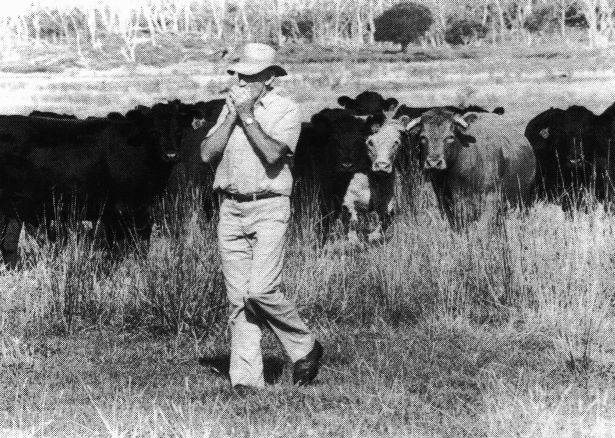
I am demonstrating the art of calling up cattle
that are not used to being in close proximity to people.
Cattle not only know which species of tree is the best to sleep under, they also have theirown social structure. Cows have a 'pecking order' with some having a senior place in the herd. The bulls have the same social positions, mostly obtained by strength and fighting ability. However, at times bulls can gang up on one bull and send him into seclusion, by actually putting him out of the herd. He is even afraid to eat during daylight hours and like a wild beast eats at night or on his own.
This often happens if five or six bulls are turned Out with say 300 to 400 cows. They then pick on one and put him out of the herd. This usually happens when most of the cows have been served. This happened at Wyambi, but at Rushy Lagoon, with bigger mobs and some thousands of acres, it does not seem to apply.
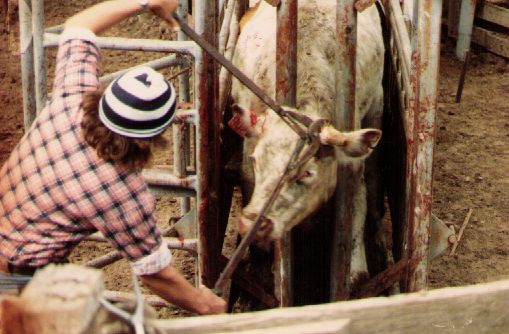
Steer being dehorned.
Without horns they lose all fear of larger cattle.
Australia's loss by bruising estimated at over $20 million per annum.
The bruising is reduced when they are dehorned.
However, on one occasion our son John, with John Groves, decided to collect one of these bulls. I warned John that the bull had turned into a 'rogue bull' similar to a rogue lion or elephant that had been turned out of the herd. Hunters in Africa and elsewhere always say beware of the 'rogue male' of any species.
John said, He'll be right Dad. He's very quiet and we will drive
a mob of steers with him
. Anyhow John arrived back at Scottsdale
with a broken ankle and knocked about a bit. I asked him how it bad
happened and he mentioned they had driven a mob of steers to the bull,
but he had charged out of the mob and hit John's horse three times
before knocking it over with John underneath.
I could not understand how John and his stock horse would allow
a bull to hit them three times, especially with his mate handy, and said
so. John said, Well Dad, I wasn't riding my horse. I was riding
Propsting's mare and she was in season, and Johnny Groves was riding
David Probert's stallion. Because the mare was in season, she did not
move and Johnny Groves did not want to bring the stallion too close.
I had to laugh at these youngsters.
Later we were fixing our boundary fence on the beach, when Dick Richey came over and spoke to us from the air. He then landed the plane on the beach, asked John if his ankle would be O.K. for football, a very important subject in our district, and then took off. Dick was a wonderful chap, one of the first in Australia using an aeroplane for spotting fish.
When John was missing, presumed drowned, Dick left his boats at a minute's notice and joined in an aerial, ground and water search for John. Dick gave aerial support for thirty-two water accidents on a voluntary basis. His son Stuart is carrying on his father's wonderful fishing enterprises. They are a great family.
We have had a bit of trouble with the calving of our young Hereford heifers, which we joined when 15 months old for calving at about two years old. We had been joining them with Angus bulls, but because the calves were too big, it created a big problem.
1989-90 we had 4,000 cows calving without any problems, but the previous year 600 two-year-old maiden heifers had a very bad time. We lost 63 heifers and 129 calves, and it cost us a lot of money going around them mornings and evenings, so now we have again joined our 15 month-old heifers with a Jersey bull. This has been done in quite a few places.
The pure bred Jersey is a poor beef breed and I did not think I would ever join a beef cow with a Jersey bull. But the Jersey cross is a very small calf, and although without the potential of the Hereford, is still a good beast. The Jersey cross breed has an excellent marbling ability and a good eye-fillet.
Jersey meat is inclined to be a bit yellow. Of course, meat can be yellow because of the carotene in the clover, but the Jersey is known to have yellow fat. However, no-one can really taste in a blindfold test any difference between an Angus and Jersey steak or any other steak.
I was at the abattoirs when one chap was selling all his Hereford
cattle, and they were all going through the meat chain. He said to me,
Look at that beautiful beast of mine there
. I replied, That is not
yours; it is mine
. And I proved it was. Oh
, he said, this is
mine
, pointing to another carcase, only to be caught out again when
I replied, No, that is mine, too
. This shows that when you take the
skin off it is very hard to tell the difference.
Of course, the Hereford and Angus have better hindquarters than the Jersey. However, I know a person who has calved 450 maiden heifers a year for the past three years. He rides around them only once a week and has no losses or problems at all. It is better to have an 80 per cent value in a live calf than a lOOper cent in a dead calf, plus often a dead mother. That does not pay the interest bills.
We are artificially inseminating a hundred of our pick Hereford cows - we have nearly 5,000 cows to pick from, a very big genetic base, with some of the best semen we can procure. The result is far easier calving, therefore low birth weights, but with a high maturity weight, plus of course sound feet, good eye pigmentation etc. Our Hereford herd are very good milkers with good mothering ability, plus good udders and generally easy calving characteristics, as long as we use the right bulls.
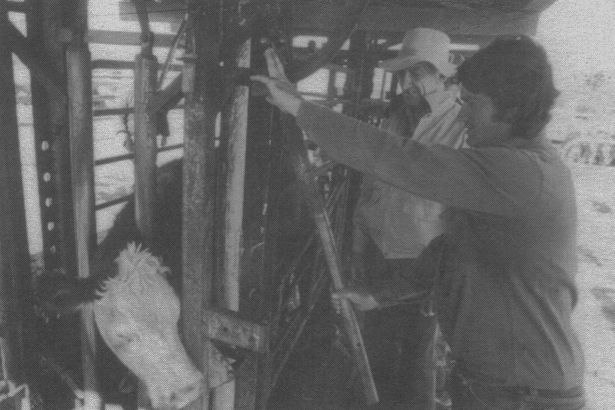
David Probert and myself checking cows for breeding.
So I think we will have a lot fewer problems in future. When we were in Canada, Peg and I stayed on a couple of cattle ranches. The people there let all their cows calve themselves and did not worry about them. They really looked after their two-year-old heifers when calving in a yard close to their home, with searchlights on at night, and they stayed up night and day watching over them. But after they had calved once the animals looked after themselves.
Most of our cows are good calvers; if not they do not live to tell the tale, because they just do not survive. But if we calve them at two years old we have to go out of our way to help them. That is sound economics.
We are crossing some of our Herefords with Angus to get a crossbred, which is a black baldy. The calves thrive and do better than a straight breed. They also become very good big bullocks, suitable for the export trade.
Only recently the Angus people imported a lot of Canadian blood into their Angus cattle. I think the Canadians must have put some of their big type of bulls to their cows to get extra big cattle. Some years ago the trend was for smaller, dumpy, quick-maturing cattle, but now the trend is for bigger Angus cattle. They are quite good beasts, but they can be dynamite on little Hereford heifers.
We found that even our own Hereford bulls were better than the Angus we were using, and of course we have to spend a lot of time with them. Time is expensive, and there are quite a few losses.
Generally speaking, a heifer which has a good length between hips and pins will calve more easily than one which is short in this area.
However, if they are only fifteen months old they can still have problems. Like some other Hereford breeders, we were joining our fifteen month old heifers to a Jersey. They do not have such good calves, but if you sell them as vealers or fatten them early in their life, you can get a reasonable price. Often a brindle steer will fatten earlier than a straight Hereford, but if kept, will not make such a good bullock. Now in 1990 we have sold all our Jersey bulls because of our successful Hereford A. I. programme to produce low birth weight/high maturity weight offspring.
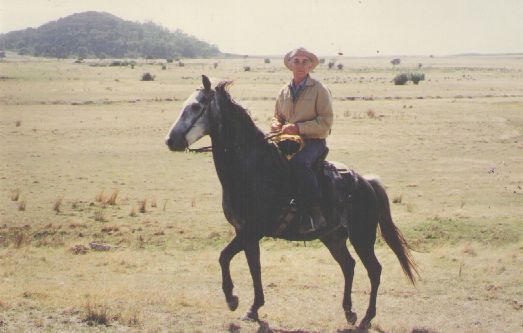 >
>
I am riding Nile's horse
We gather our cattle with horses. We tried motor bikes, but they stirred the cattle too much, so we went back to horses. We worked with a helicopter the first year after we bought the property, but we haven't such vast areas as they have on the mainland, where helicopters are very good, and their use is not really profitable for us.
Cattle do not seem to be so frightened by horses and will follow them through bush or be driven by horses quite easily, whereas if they get to the yards after motor bikes have split them up, they are wound up and nervous.
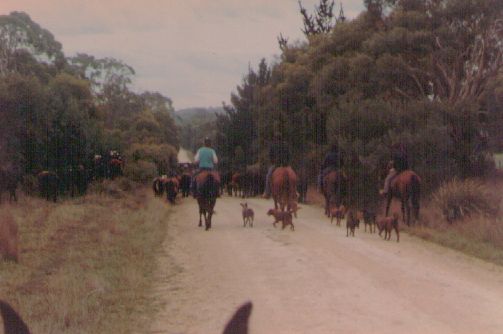
Driving cattle to stockyards.
I planted trees (grown from seed) for shelter belts in 1964.
We have about 40 horses, all grass-fed, which are quite good. We also use dogs, and the horsemen have good control over them when used with either cattle or sheep.
But the Canadians were amazing. They did not seem to use dogs or whips on the ranches I visited. They said they really should come to Australia and learn how to use dogs and buy some to take back with them. They keep calling, trying to get cattle out of the brush in big gullies on their 80,000 and 50,000 acre ranches without stockwhips. And yet at the Calgary Stampede I saw a girl who could do everything with a stockwhip; she could really make it talk. One would have thought it would have been far more effective to use stockwhips to get cattle out of the rough brakes. The crack of a stockwhip should bring cattle out of these brakes far more easily than a man's shouting and, of course, it would be a lot easier on his lungs.
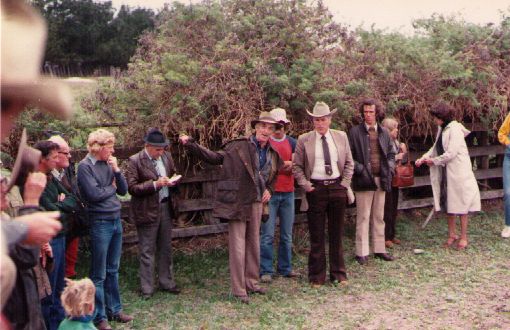
Angus Society of Australia Field Day at West Wyambi
stock yards, 21st April 1981
Professor Roger Hunsley, or Purdue University, USA.
Note shelter shrubs planed adjoining stock yards.
I realise that in the Northern Hemisphere the cattle do mostly have to come out of the area before it snows. Some make it down to the low country, but others become trapped in gullies, and unless they are got out in time they become snowed in and die. The ranches in Canada where we stayed had snow ploughs, motor scooters, aeroplanes - they had the lot!
We have two-way transistors for use on our horses so the riders can keep in contact with one another, because we still have quite a lot of wild cattle. Cars, Land Rovers and tractors are all connected by two- way radio to the base stations at our office at Scottsdale and, now with the purchase of Rushy Lagoon, also to Gladstone base station operated by Jill Probert.
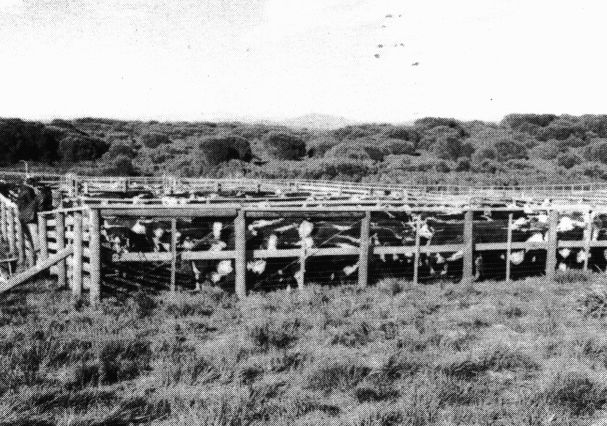
Stockyards constructed with rails and wire rope to trap wild cattle.
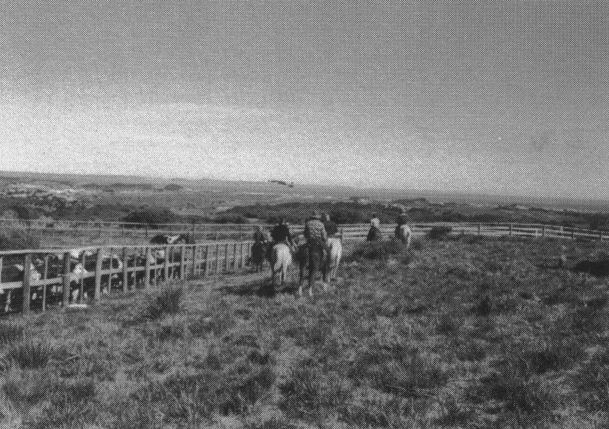
First round-up of cattle from Sandbanks using these yards - March 31st 1987.
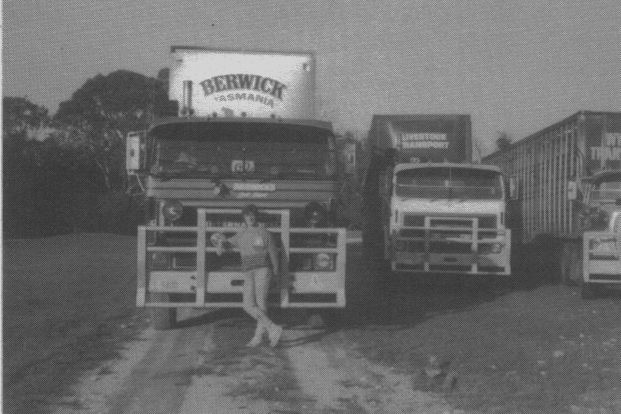
1989- Three of the six trucks loading cattle at the East Wyambi stockyards.
Overseer's wife, Jill, in foreground.
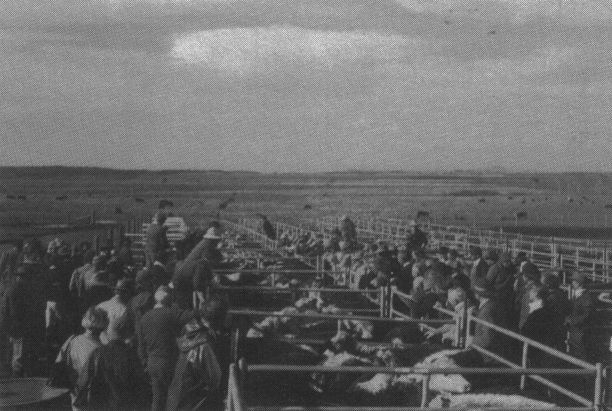
Our first large on site sale of 1 000 cattle at Rushy Lagoon in 1989
There were up to 150 wild cattle that could not be rounded up in the time given to us when we first bought the property, and there are still between 20 and 30 wild bulls and steers roaming around out there. We built very powerful stockyards, with wire ropes and high fences in the area where these wild cattle were living, along a nine-mile stretch of sea coast and going back into the hills. They are really survivors, as was shown when we had a flood in the area. The flood, in the Ringarooma River, cost us 30 cattle, some of which were found 10 feet up in the forks of trees, but the wild ones escaped because they knew what to do.
After we bought Rushy Lagoon we had some Charolais and different other European breeds on our little farm at Scottsdale, so we sent out 15 of these two-year-old steers that were half-fat to quieten the wild cattle down, thinking this would make it easier to bring them in. But we had to winch eight of these paddock-bred cattle out of the bogs when they tried to follow the wild ones through the marshes!
We brought some of these Herefords (not the wild ones) into Scottsdale and tried them over the back of our farm where there was a little boggy patch. We put them with five big Charolais steers, which would be about 700 lb or about 318kg dressed weight, and two of them were bogged and died trying to follow the Herefords through this bog. Yet these Charolais had been in this paddock for more than 12 months.
The Charolais is a very good beast, but is a paddock beast, in my opinion. I have seen some very good Charolais throughout Europe, and very good Simmental cattle too, and we have very good ones ourselves, so I am not trying to run them down. Many people do not have these boggy areas on their properties, so they do not have to worry. Herefords will walk with a good swing, and this helps them in rough country, but this is not necessarily an advantage on level pasture or a feed lot.
It is very necessary to keep cattle quiet and contented. It is easier for the staff and the animals fatten more quickly. This is particularly noticeable with dehorning cattle. It is a temporary hurt, like a tooth extraction, but then for the rest of their lives they do not need to be frightened of the horns of the other cattle. As mentioned, the temporary loss of blood is beneficial healthwise.
When reasonably wild cattle arrive ata new area, they can be very restless and break down fences to get back to the environment they have been used to. However, if you light a log fire they will stand around the fire and not feel so frightened or threatened.
If you walk among wild cattle and look at them in the face it is a challenge and they feel they must charge or run away. Old Charlie Brown claimed no bull will ever hit you, if you do not look at him. I would want a mirror to be sure!